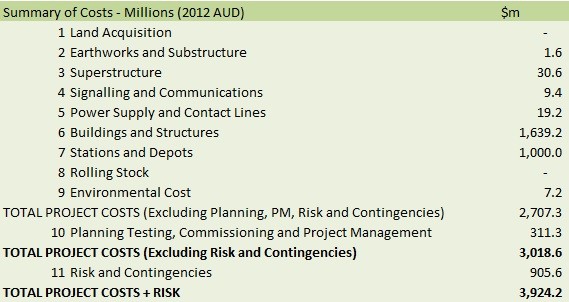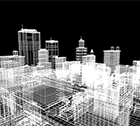
Last week I discussed the worrying tendency of some involved in public discussion of urban issues to treat the facts as if they’re optional (Infrastructure: does getting the facts right matter anymore?). In particular, I pointed to a list of rail projects formulated by Trains Not Toll Roads where the claimed costs in some instances are, I believe, misleadingly low.
One of those projects is the proposed Melbourne Metro rail tunnel. Trains Not Toll Roads, acting on the basis of research by the transport team at Beyond Zero Emissions Inc (BZE), claims the cost of construction would be $3 billion. This is wildly at odds with the accepted estimate of at least $9 billion.
BZE haven’t made their calculations public, but the organisation’s Media Coordinator, Ben Courtice, sent me a spreadsheet showing the major cost categories used to arrive at the estimate (see exhibit). I’ve sought some expert opinion on BZE’s calculations in an effort to understand the enormous divergence between the two figures. What follows isn’t exhaustive, but it indicates some of the key cost areas omitted from the $3 billion estimate.
Most of the $3 billion was arrived at by two calculations. First, $1.6 billion comes from multiplying the length of the tunnel (9.6 km) by an assumed average cost of $0.17 billion per kilometre (taken from the Phase 2 HSR study).
Second, a further $1 billion comes from building five stations at an assumed average cost of $0.2 billion each (no source provided). These two figures come to $2.6 billion – the lion’s share of the remaining $0.4 billion is attributed to Planning and Project Management.
The first thing to note is the $3 billion estimate doesn’t include any allowance for Risk and Contingencies. However the spreadsheet provided to me by BZE allows $0.9 billion for this component, bringing BZE’s estimate of the total cost to $3.9 billion, as per the exhibit. Yet strangely, this much higher estimate isn’t shown on the Trains Not Toll Roads web site.
The 30% allowance for Risk and Contingencies assumed by BZE might be acceptable when a lot of detailed work to prove-up a project has been put into the front end (the Government has allocated about $50 million to Melbourne Metro). However when the costings are based on very simple formulas without regard to the special circumstances of a project, a much higher allowance must be made.
There are also some areas of serious cost under-estimation in BZE’s analysis. Nothing has been allowed for Land Acquisition; just $1.6 million for Earthworks and Substructure; $30.6 million for Superstructure; and a mere $9 million for Signalling and Communications.
This might seem natural to a layperson as the Metro’s a tunnel, but it will have to be retro-fitted into a dense and busy urban area. It will require acquisition of expensive inner city and CBD land for stations and for staging construction. Adjacent land, extensive earthworks and large portal structures will be required where the line comes to the surface at Kensington and South Yarra.
Junctions will be needed to connect to existing lines and they will have to be built without disrupting services. Introducing new signalling technology is likely to be complex and the existing rail lines will require upgrades to the more advanced train control system.
BZE assume the five stations will cost $0.2 billion each, but it doesn’t appear that they’re aware Metro line trains will be 220 metres long (1.5 times current length). The Phase 2 HSR report (which BZE relies on for guidance on tunnelling costs) allows $0.46 billion for a single CBD station in Melbourne (1).
The estimates also make no provision for train maintenance and stabling facilities, for design and contractors overheads, or for provision of a train control centre. As increasing the number of services on suburban lines is a key benefit of the Metro (and no doubt contributes to the positive benefit-cost ratio), the cost to remove bottlenecks on these lines is also arguably a cost of the project.
I’m not in a position to say definitively whether or not the $9 billion estimate for Melbourne Metro is right (although Bent Flyvbjerg’s research indicates transport projects tend to exceed budget, so preliminary costings are likely to be even more ropey), but I think it’s pretty clear the claimed cost of $3 billion is misleading. The real reason for the difference between the published figures is political, not technical (2).
As I’ve noted before, the key priority for improving cities shouldn’t be to deny reality, however unpalatable, but to understand why urban infrastructure costs so much and what can be done about it (e.g. see Why is infrastructure so bloody expensive?; Why do subways cost so much more here than elsewhere?; and If WA can build rail lines cheaply, why can’t the other States?).
__________________________________________
- Stations can be very expensive. Although it’s not directly comparable because it’s a renovation and is above ground, the indicative cost to redevelop Flinders St Station in line with the winning design in the recent architectural competition is in the order of $1 – 1.5 billion.
- Those who saw the story in The Age last Saturday (Time to unearth London secrets) claiming London is building 42 km of tunnel for $25 billion should note that the it’s actually 21 km (it’s dual tunnel; the reporter counted both). That comes to $1.2 billion/km, similar to the (real) estimated cost of Melbourne Metro.








Crikey is committed to hosting lively discussions. Help us keep the conversation useful, interesting and welcoming. We aim to publish comments quickly in the interest of promoting robust conversation, but we’re a small team and we deploy filters to protect against legal risk. Occasionally your comment may be held up while we review, but we’re working as fast as we can to keep the conversation rolling.
The Crikey comment section is members-only content. Please subscribe to leave a comment.
The Crikey comment section is members-only content. Please login to leave a comment.